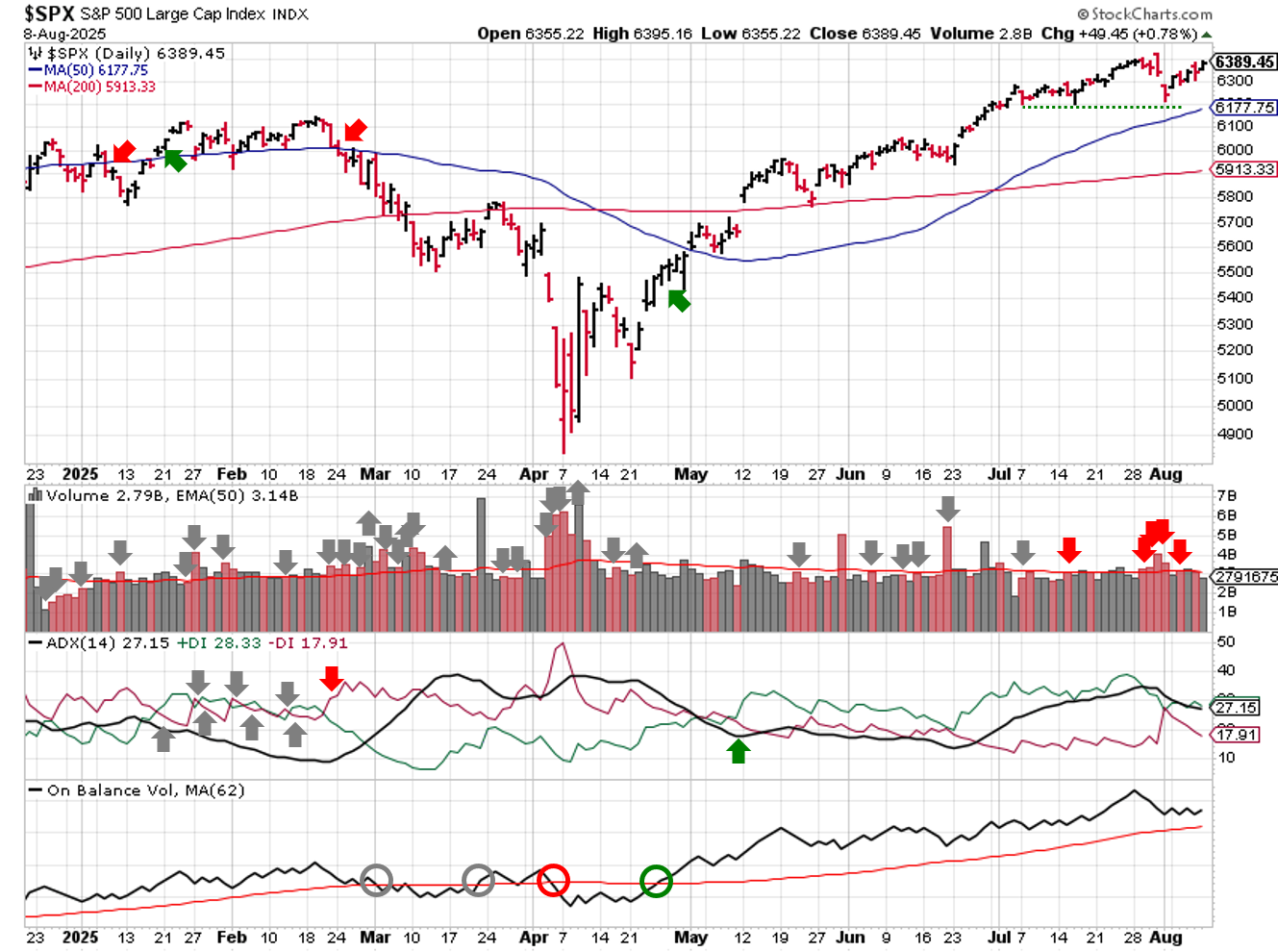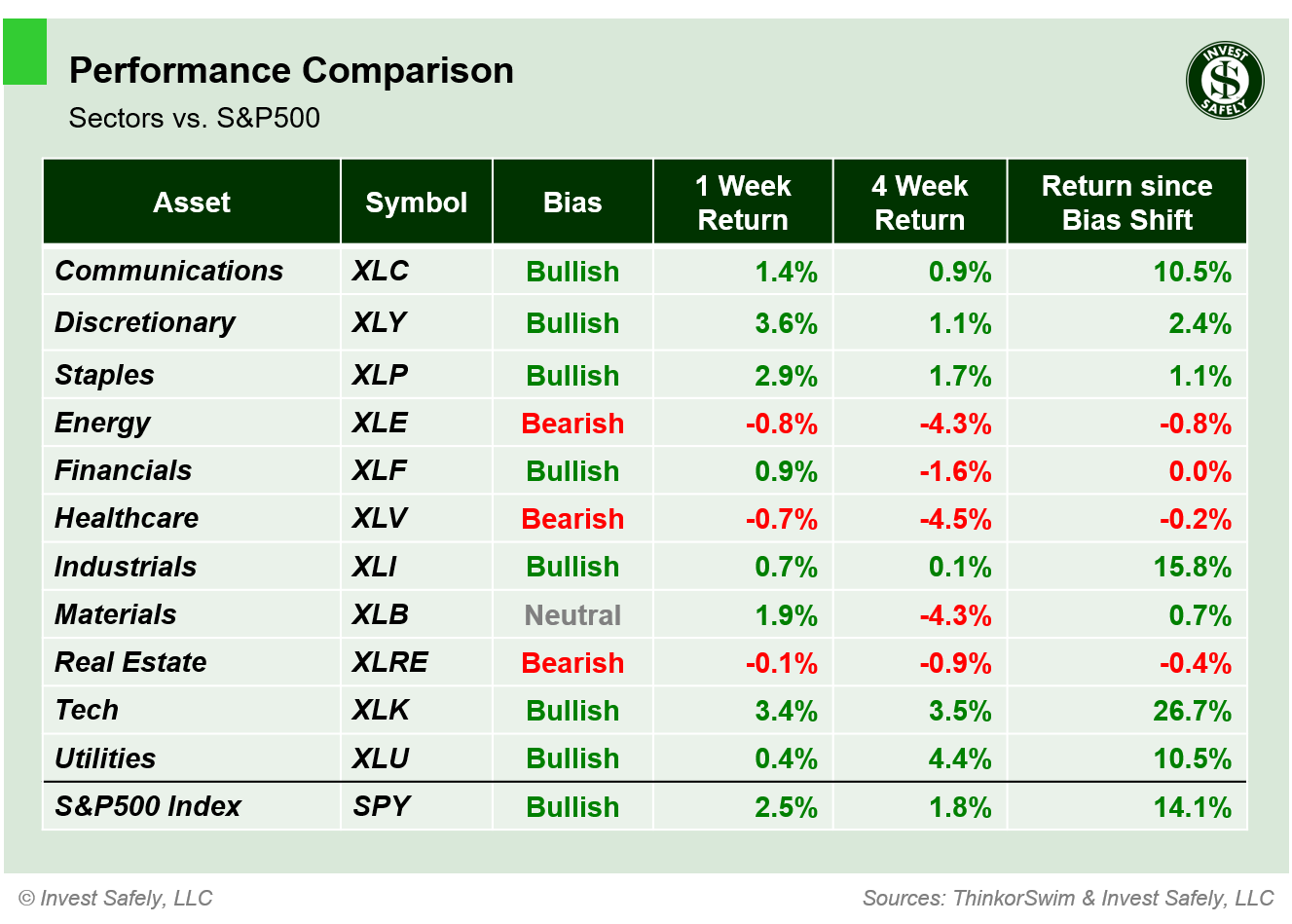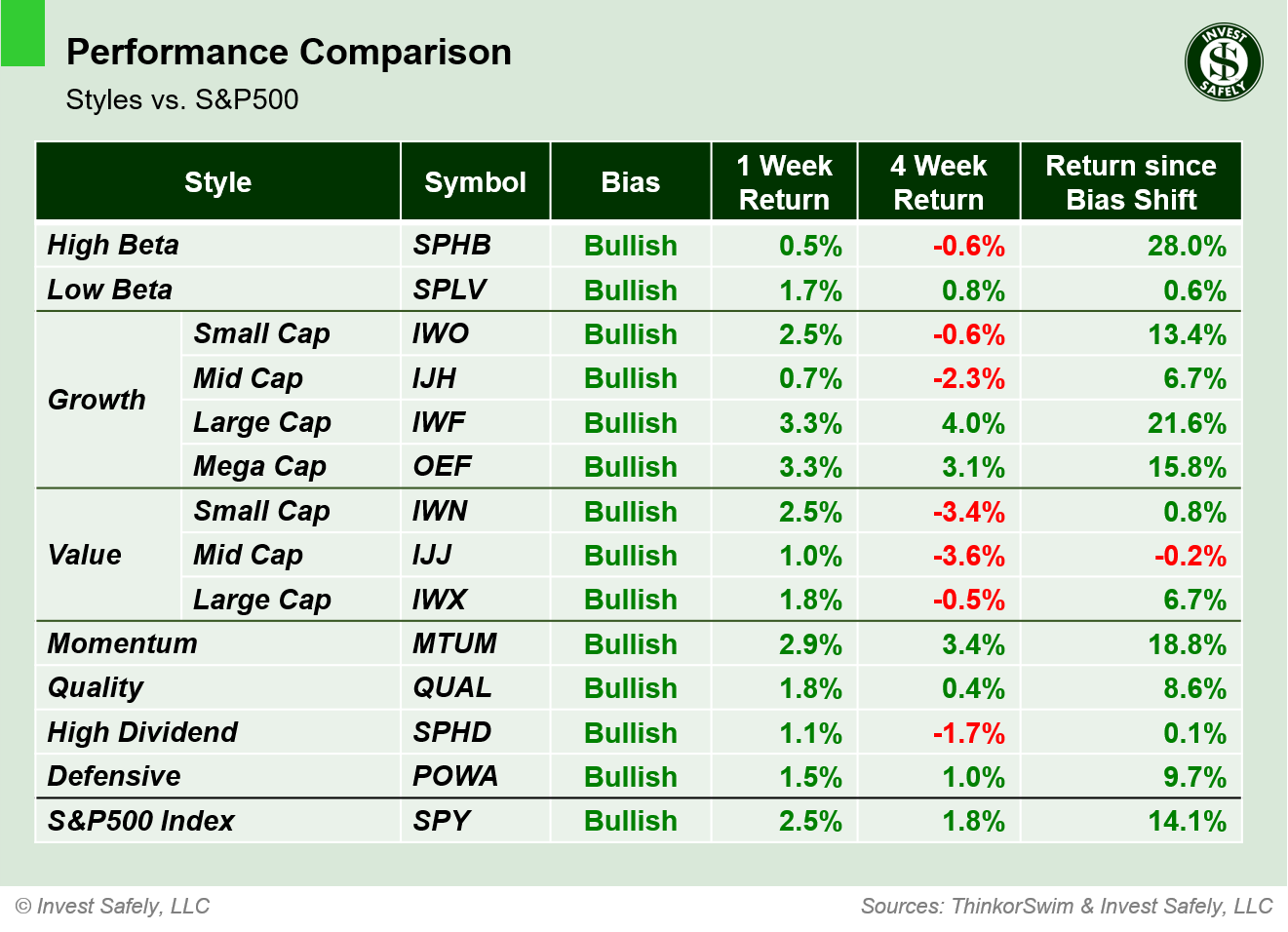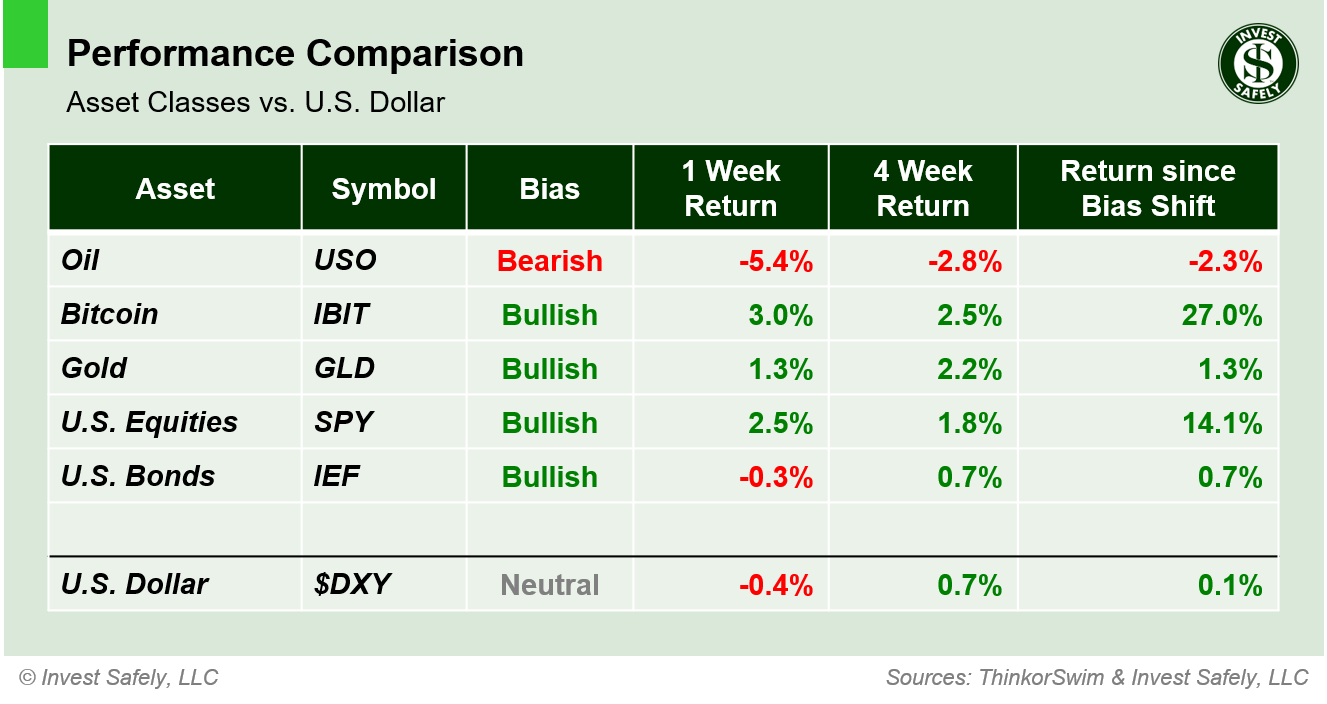Stock Market Outlook
For The Week Of August 10th = Uptrend
INDICATORS
-
ADX Directional Index: Uptrend
Institutional Activity: Uptrend
On Balance Volume: Uptrend
ANALYSIS
The stock market outlook continues to show an uptrend for U.S. equities.
The S&P500 ( $SPX ) rose 2.4%. The index sits ~3% above the 50-day moving average and ~8% above the 200-day moving average.
The ADX directional indicator rejoins Institutional Activity and On-Balance Volume in bullish territory. Distribution days ticked up heading into August; something to keep an eye.
SPX Technical Analysis - August 03 2025
PERFORMANCE COMPARISONS
Consumer Discretionary ( $XLU ) led sectors higher, while Energy and Healthcare ( $XLE & $XLV ) underperformed. Discretionary, Staples, and Financials ( $XLY, $XLP, $XLF ) returned to bullish bias; Materials ( $XLB ) eased back to Neutral and Energy ( $XLE ) fell to bearish.
S&P500 Sector Performance - August 10 2025
All sector styles gained last week; Mega Cap Growth ( $OEF ) led the charge and High Beta ( $SPHB ) brought up the rear. Last weeks laggards ( $SPLV, $IWN, $IJJ, $IWX, $SPHD ) all regained bullish bias.
S&P500 Sector Style Performance - August 10 2025
In a reversal from the prior week, Oil ( $USO ) underperformed other assets and Bitcoin ( $IBIT ) outperformed. Oil also fell back to bearish bias.
Asset Class Performance - August 10 2025
COMMENTARY
Earning season is winding down and a majority of companies ( >80% ) beat their Q2 earnings estimates. Most estimates were lowered in anticipation of tariffs, which were largely delayed until earlier month, so that feat is slightly less impressive than it first appears. The full impact of new tariffs likely hits Q4 earnings data. Year over year earnings growth in quarterly earnings is still positive though, which is good.
ISM Services PMI dropped to 50.1 in July, down from June's from 50.8 in June and below forecasts of 51.5. Within that data, the Services Prices Index rose to 69.9, the highest since October 2022. For reference, this sub-index measures the prices that service businesses are paying for inputs ( e.g. materials and services ), and is a key indicator of inflationary pressures in the services sector.
This week we get the latest CPI and PPI inflation data, along with retail sales and consumer sentiment.
Elsewhere, President Trump signed an executive order to expand Americans' access to alternative investments in their 401(k) retirement plans ( cryptocurrency, private equity, and real estate ). While a lot of ink was spilled about the impact on financial markets, keep in mind this is the federal government we're talking about, so changes could take years.
First, the SEC, U.S. Treasury, and Department of Labor need to rewrite the regulations that define what qualifies as a permissible 401(k) asset. Then 401k providers must provide new investment options within those rules. And then employers add those options to their 401k plans.
Despite the bounce back by several sectors and styles, August is a seasonally weak period for U.S. equities, and another reason we raised some caution flags last week. Since 1990, this time period has the highest rate of change in volatility, and the second worst monthly returns. The worst monthly returns? September. So don't be surprised if prices continue to chop around. Take an extra moment to review your stop levels, max loss amounts, and profit targets for any new and/or existing positions.
Best to Your Week!
P.S. If you find this research helpful, please tell a friend.
If you don't, tell an enemy.
Sources: Bloomberg, CNBC, Federal Reserve Bank of St. Louis, Hedgeye, U.S. Bureau of Economic Analysis, U.S. Bureau of Labor Statistics, TradingEconomics.com
Share this on social media:
Find articles and other news of interest from Invest-Safely:
Twitter (@investsafely)
Facebook (@InvestSafely)
LinkedIn (@Invest-Safely)
Instagram (@investsafely)
 If you're interested in learning more about the relationship between price and volume, or how to find and trade the best stocks for your growth strategy, check out this book via the following Amazon affiliate link:
If you're interested in learning more about the relationship between price and volume, or how to find and trade the best stocks for your growth strategy, check out this book via the following Amazon affiliate link:
How to Make Money in Stocks: A Winning System in Good Times and Bad.
It's one of my favorites.
Invest Safely, LLC is an independent investment research and online financial media company. Use of Invest Safely, LLC and any other products available through invest-safely.com is subject to our Terms of Service and Privacy Policy. Not a recommendation to buy or sell any security.
Charts provided courtesy of stockcharts.com.
For historical Elliott Wave commentary and analysis, go to ELLIOTT WAVE lives on by Tony Caldaro. Current counts can be found at: Pretzel Logic, and 12345ABCDEWXYZ
Once a year, I review the market outlook signals as if they were a mechanical trading system, while pointing out issues and making adjustments. The goal is to give you to give you an example of how to analyze and continuously improve your own systems.
- 2015 Performance - Stock Market Outlook
- 2016 Performance - Stock Market Outlook
- 2017 Performance - Stock Market Outlook
- 2018 Performance - Stock Market Outlook
- 2019 Performance - Stock Market Outlook
- 2020 Performance - Stock Market Outlook
IMPORTANT DISCLOSURE INFORMATION
This material is for general communication and is provided for informational and/or educational purposes only. None of the content should be viewed as a suggestion that you take or refrain from taking any action nor as a recommendation for any specific investment product, strategy, or other such purpose. Certain information contained herein has been obtained from third-party sources believed to be reliable, but we cannot guarantee its accuracy or completeness.
To the extent that a reader has any questions regarding the applicability of any specific issue discussed above to his/her individual situation, he/she is encouraged to consult with the professional advisors of his/her choosing. Invest Safely, LLC is not a law firm, certified public accounting firm, or registered investment advisor and no portion of its content should be construed as legal, accounting, or investment advice.
The material is not to be construed as an offer or a recommendation to buy or sell a security nor is it to be construed as investment advice. Additionally, the material accessible through this website does not constitute a representation that the investments described herein are suitable or appropriate for any person.
Hypothetical Presentations:
Any referenced performance is “as calculated” using the referenced funds and has not been independently verified. This presentation does not discuss, directly or indirectly, the amount of the profits or losses, realized or unrealized, by any reader or contributor, from any specific funds or securities.
The author and/or any reader may have experienced materially different performance based upon various factors during the corresponding time periods. To the extent that any portion of the content reflects hypothetical results that were achieved by means of the retroactive application of a back-tested model, such results have inherent limitations, including:
Model results do not reflect the results of actual trading using assets, but were achieved by means of the retroactive application of the referenced models, certain aspects of which may have been designed with the benefit of hindsight
Back-tested performance may not reflect the impact that any material market or economic factors might have had on the use of a trading model if the model had been used during the period to actually manage assets
Actual investment results during the corresponding time periods may have been materially different from those portrayed in the model
Past performance may not be indicative of future results. Therefore, no one should assume that future performance will be profitable, or equal to any corresponding historical index.
The S&P 500 Composite Total Return Index (the "S&P") is a market capitalization-weighted index of 500 widely held stocks often used as a proxy for the stock market. Standard & Poor's chooses the member companies for the S&P based on market size, liquidity, and industry group representation. Included are the common stocks of industrial, financial, utility, and transportation companies. The S&P is not an index into which an investor can directly invest. The historical S&P performance results (and those of all other indices) are provided exclusively for comparison purposes only, so as to provide general comparative information to assist an individual in determining whether the performance of a specific portfolio or model meets, or continues to meet investment objective(s). The model and indices performance results do not reflect the impact of taxes.
Investing involves risk (even the “safe” kind)! Past performance does not guarantee or indicate future results. Different types of investments involve varying degrees of underlying risk. Therefore, do not assume that future performance of any specific investment or investment strategy be suitable for your portfolio or individual situation, will be profitable, equal any historical performance level(s), or prove successful (including the investments and/or investment strategies describe on this site).






